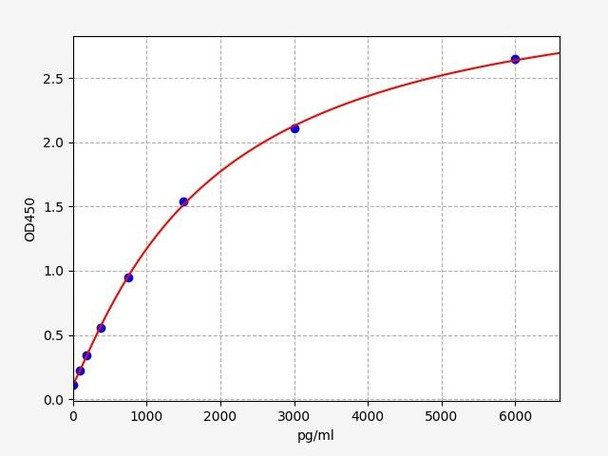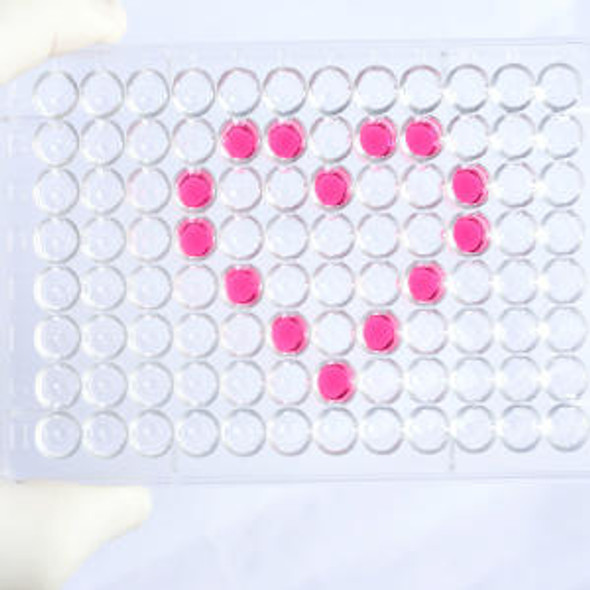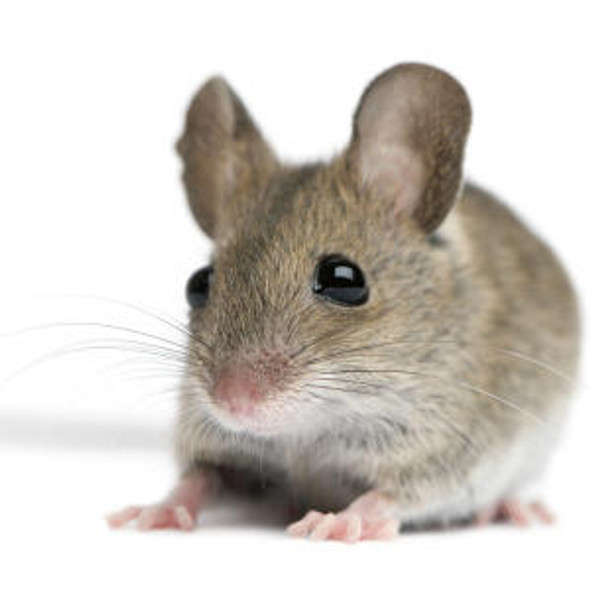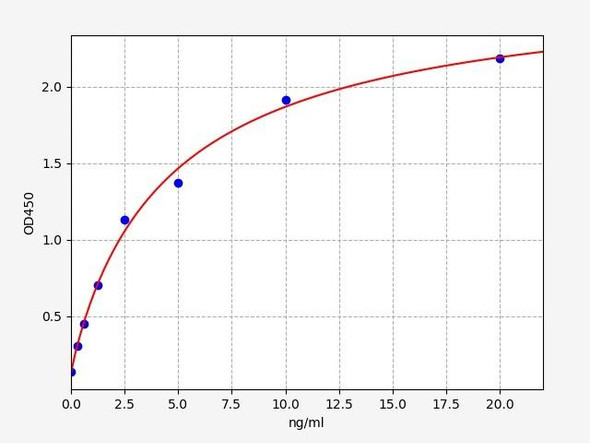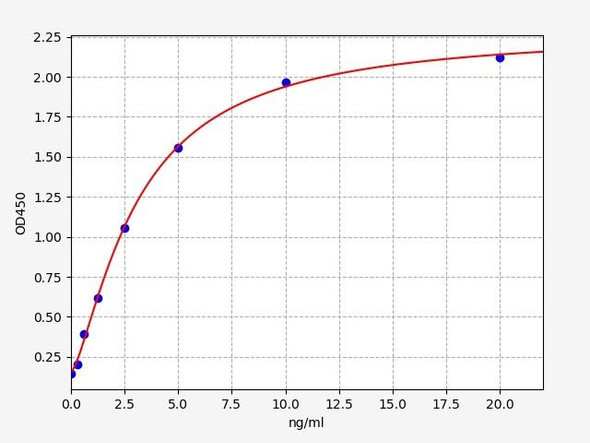Human MASP1 ELISA Kit
- SKU:
- HUFI01669
- Product Type:
- ELISA Kit
- Size:
- 96 Assays
- Uniprot:
- P48740
- Sensitivity:
- 56.25pg/ml
- Range:
- 93.75-6000pg/ml
- ELISA Type:
- Sandwich ELISA, Double Antibody
- Synonyms:
- MASP1, Mannan-binding lectin serine protease 1, Serine protease 5, Ra-reactive factor serine protease p100, RaRF, Mannose-binding protein-associated serine protease, Mannose-binding lectin-associated serine protease 1, MASP-1, Complement factor MASP-
- Reactivity:
- Human
Description
| Product Name: | Human MASP1 ELISA Kit |
| Product Code: | HUFI01669 |
| Size: | 96 Assays |
| Alias: | MASP1, Mannan-binding lectin serine protease 1, Serine protease 5, Ra-reactive factor serine protease p100, RaRF, Mannose-binding protein-associated serine protease, Mannose-binding lectin-associated serine protease 1, MASP-1, Complement factor MASP-3, Complement-activating component of Ra-reactive factor, CRARF, CRARF1, PRSS5 |
| Detection method: | Sandwich ELISA, Double Antibody |
| Application: | This immunoassay kit allows for the in vitro quantitative determination of Human MASP1 concentrations in serum plasma and other biological fluids. |
| Sensitivity: | 56.25pg/ml |
| Range: | 93.75-6000pg/ml |
| Storage: | 4°C for 6 months |
| Note: | For Research Use Only |
| Recovery: | Matrices listed below were spiked with certain level of Human MASP1 and the recovery rates were calculated by comparing the measured value to the expected amount of Human MASP1 in samples. | ||||||||||||||||
| |||||||||||||||||
| Linearity: | The linearity of the kit was assayed by testing samples spiked with appropriate concentration of Human MASP1 and their serial dilutions. The results were demonstrated by the percentage of calculated concentration to the expected. | ||||||||||||||||
| |||||||||||||||||
| CV(%): | Intra-Assay: CV<8% Inter-Assay: CV<10% |
| Component | Quantity | Storage |
| ELISA Microplate (Dismountable) | 8×12 strips | 4°C for 6 months |
| Lyophilized Standard | 2 | 4°C/-20°C |
| Sample/Standard Dilution Buffer | 20ml | 4°C |
| Biotin-labeled Antibody(Concentrated) | 120ul | 4°C (Protect from light) |
| Antibody Dilution Buffer | 10ml | 4°C |
| HRP-Streptavidin Conjugate(SABC) | 120ul | 4°C (Protect from light) |
| SABC Dilution Buffer | 10ml | 4°C |
| TMB Substrate | 10ml | 4°C (Protect from light) |
| Stop Solution | 10ml | 4°C |
| Wash Buffer(25X) | 30ml | 4°C |
| Plate Sealer | 5 | - |
Other materials and equipment required:
- Microplate reader with 450 nm wavelength filter
- Multichannel Pipette, Pipette, microcentrifuge tubes and disposable pipette tips
- Incubator
- Deionized or distilled water
- Absorbent paper
- Buffer resevoir
| Uniprot | P48740 |
| UniProt Protein Function: | MASP1: Functions in the lectin pathway of complement, which performs a key role in innate immunity by recognizing pathogens through patterns of sugar moieties and neutralizing them. The lectin pathway is triggered upon binding of mannan-binding lectin (MBL) and ficolins to sugar moieties which leads to activation of the associated proteases MASP1 and MASP2. Functions as an endopeptidase and may activate MASP2 or C2 or directly activate C3 the key component of complement reaction. Isoform 2 may have an inhibitory effect on the activation of the lectin pathway of complement or may cleave IGFBP5. Defects in MASP1 are the cause of 3MC syndrome type 1 (3MC1). 3MC1 is a disorder characterized by facial dysmorphism that includes hypertelorism, blepharophimosis, blepharoptosis and highly arched eyebrows, cleft lip and/or palate, craniosynostosis, learning disability and genital, limb and vesicorenal anomalies. The term 3MC syndrome includes Carnevale, Mingarelli, Malpuech, and Michels syndromes. Belongs to the peptidase S1 family. 4 isoforms of the human protein are produced by alternative splicing. |
| UniProt Protein Details: | Protein type:EC 3.4.21.-; Protease; Secreted, signal peptide; Secreted Chromosomal Location of Human Ortholog: 3q27-q28 Cellular Component: extracellular space; extracellular region Molecular Function:peptidase activity; protein binding; protein homodimerization activity; serine-type endopeptidase activity; calcium ion binding; calcium-dependent protein binding Biological Process: receptor-mediated endocytosis; negative regulation of complement activation; innate immune response; proteolysis; complement activation, lectin pathway; complement activation Disease: 3mc Syndrome 1 |
| NCBI Summary: | This gene encodes a serine protease that functions as a component of the lectin pathway of complement activation. The complement pathway plays an essential role in the innate and adaptive immune response. The encoded protein is synthesized as a zymogen and is activated when it complexes with the pathogen recognition molecules of lectin pathway, the mannose-binding lectin and the ficolins. This protein is not directly involved in complement activation but may play a role as an amplifier of complement activation by cleaving complement C2 or by activating another complement serine protease, MASP-2. The encoded protein is also able to cleave fibrinogen and factor XIII and may may be involved in coagulation. A splice variant of this gene which lacks the serine protease domain functions as an inhibitor of the complement pathway. Alternate splicing results in multiple transcript variants.[provided by RefSeq, Apr 2010] |
| UniProt Code: | P48740 |
| NCBI GenInfo Identifier: | 218512135 |
| NCBI Gene ID: | 5648 |
| NCBI Accession: | P48740.3 |
| UniProt Secondary Accession: | P48740,O95570, Q68D21, Q8IUV8, Q96RS4, Q9UF09, A8K542 A8K6M1, B4E2L7, |
| UniProt Related Accession: | P48740 |
| Molecular Weight: | 699 |
| NCBI Full Name: | Mannan-binding lectin serine protease 1 |
| NCBI Synonym Full Names: | mannan-binding lectin serine peptidase 1 (C4/C2 activating component of Ra-reactive factor) |
| NCBI Official Symbol: | MASP1 |
| NCBI Official Synonym Symbols: | 3MC1; MAP1; MASP; RaRF; CRARF; MASP3; MAp44; PRSS5; CRARF1 |
| NCBI Protein Information: | mannan-binding lectin serine protease 1; serine protease 5; complement factor MASP-3; Ra-reactive factor serine protease p100; mannose-binding protein-associated serine protease; mannose-binding lectin-associated serine protease 1; complement-activating component of Ra-reactive factor |
| UniProt Protein Name: | Mannan-binding lectin serine protease 1 |
| UniProt Synonym Protein Names: | Complement factor MASP-3; Complement-activating component of Ra-reactive factor; Mannose-binding lectin-associated serine protease 1; MASP-1; Mannose-binding protein-associated serine protease; Ra-reactive factor serine protease p100; RaRF; Serine protease 5Cleaved into the following 2 chains:Mannan-binding lectin serine protease 1 heavy chain; Mannan-binding lectin serine protease 1 light chain |
| Protein Family: | Mannan-binding lectin serine protease |
| UniProt Gene Name: | MASP1 |
| UniProt Entry Name: | MASP1_HUMAN |
*Note: Protocols are specific to each batch/lot. For the correct instructions please follow the protocol included in your kit.
Before adding to wells, equilibrate the SABC working solution and TMB substrate for at least 30 min at 37°C. When diluting samples and reagents, they must be mixed completely and evenly. It is recommended to plot a standard curve for each test.
| Step | Protocol |
| 1. | Set standard, test sample and control (zero) wells on the pre-coated plate respectively, and then, record their positions. It is recommended to measure each standard and sample in duplicate. Wash plate 2 times before adding standard, sample and control (zero) wells! |
| 2. | Aliquot 0.1ml standard solutions into the standard wells. |
| 3. | Add 0.1 ml of Sample / Standard dilution buffer into the control (zero) well. |
| 4. | Add 0.1 ml of properly diluted sample ( Human serum, plasma, tissue homogenates and other biological fluids.) into test sample wells. |
| 5. | Seal the plate with a cover and incubate at 37 °C for 90 min. |
| 6. | Remove the cover and discard the plate content, clap the plate on the absorbent filter papers or other absorbent material. Do NOT let the wells completely dry at any time. Wash plate X2. |
| 7. | Add 0.1 ml of Biotin- detection antibody working solution into the above wells (standard, test sample & zero wells). Add the solution at the bottom of each well without touching the side wall. |
| 8. | Seal the plate with a cover and incubate at 37°C for 60 min. |
| 9. | Remove the cover, and wash plate 3 times with Wash buffer. Let wash buffer rest in wells for 1 min between each wash. |
| 10. | Add 0.1 ml of SABC working solution into each well, cover the plate and incubate at 37°C for 30 min. |
| 11. | Remove the cover and wash plate 5 times with Wash buffer, and each time let the wash buffer stay in the wells for 1-2 min. |
| 12. | Add 90 µl of TMB substrate into each well, cover the plate and incubate at 37°C in dark within 10-20 min. (Note: This incubation time is for reference use only, the optimal time should be determined by end user.) And the shades of blue can be seen in the first 3-4 wells (with most concentrated standard solutions), the other wells show no obvious color. |
| 13. | Add 50 µl of Stop solution into each well and mix thoroughly. The color changes into yellow immediately. |
| 14. | Read the O.D. absorbance at 450 nm in a microplate reader immediately after adding the stop solution. |
When carrying out an ELISA assay it is important to prepare your samples in order to achieve the best possible results. Below we have a list of procedures for the preparation of samples for different sample types.
| Sample Type | Protocol |
| Serum | If using serum separator tubes, allow samples to clot for 30 minutes at room temperature. Centrifuge for 10 minutes at 1,000x g. Collect the serum fraction and assay promptly or aliquot and store the samples at -80°C. Avoid multiple freeze-thaw cycles. If serum separator tubes are not being used, allow samples to clot overnight at 2-8°C. Centrifuge for 10 minutes at 1,000x g. Remove serum and assay promptly or aliquot and store the samples at -80°C. Avoid multiple freeze-thaw cycles. |
| Plasma | Collect plasma using EDTA or heparin as an anticoagulant. Centrifuge samples at 4°C for 15 mins at 1000 × g within 30 mins of collection. Collect the plasma fraction and assay promptly or aliquot and store the samples at -80°C. Avoid multiple freeze-thaw cycles. Note: Over haemolysed samples are not suitable for use with this kit. |
| Urine & Cerebrospinal Fluid | Collect the urine (mid-stream) in a sterile container, centrifuge for 20 mins at 2000-3000 rpm. Remove supernatant and assay immediately. If any precipitation is detected, repeat the centrifugation step. A similar protocol can be used for cerebrospinal fluid. |
| Cell culture supernatant | Collect the cell culture media by pipette, followed by centrifugation at 4°C for 20 mins at 1500 rpm. Collect the clear supernatant and assay immediately. |
| Cell lysates | Solubilize cells in lysis buffer and allow to sit on ice for 30 minutes. Centrifuge tubes at 14,000 x g for 5 minutes to remove insoluble material. Aliquot the supernatant into a new tube and discard the remaining whole cell extract. Quantify total protein concentration using a total protein assay. Assay immediately or aliquot and store at ≤ -20 °C. |
| Tissue homogenates | The preparation of tissue homogenates will vary depending upon tissue type. Rinse tissue with 1X PBS to remove excess blood & homogenize in 20ml of 1X PBS (including protease inhibitors) and store overnight at ≤ -20°C. Two freeze-thaw cycles are required to break the cell membranes. To further disrupt the cell membranes you can sonicate the samples. Centrifuge homogenates for 5 mins at 5000xg. Remove the supernatant and assay immediately or aliquot and store at -20°C or -80°C. |
| Tissue lysates | Rinse tissue with PBS, cut into 1-2 mm pieces, and homogenize with a tissue homogenizer in PBS. Add an equal volume of RIPA buffer containing protease inhibitors and lyse tissues at room temperature for 30 minutes with gentle agitation. Centrifuge to remove debris. Quantify total protein concentration using a total protein assay. Assay immediately or aliquot and store at ≤ -20 °C. |
| Breast Milk | Collect milk samples and centrifuge at 10,000 x g for 60 min at 4°C. Aliquot the supernatant and assay. For long term use, store samples at -80°C. Minimize freeze/thaw cycles. |

